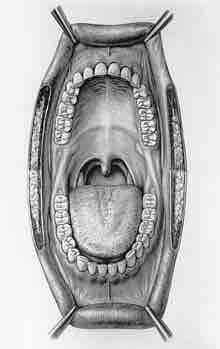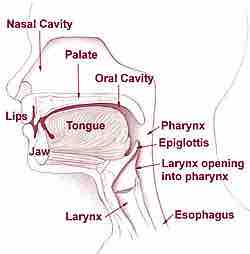The mouth is the first portion of the alimentary canal. It receives food and moistens the food with saliva, while the food is mechanically processed (mastication) by the teeth. The mouth is also known as the oral cavity, and within the oral cavity sits the tongue, the soft and hard palate, the uvula, and numerous salivary glands. The oral mucosa is the mucous membrane epithelial tissue that lines the inside of the mouth. This membrane maintains a moist and lubricated environment within the mouth, preparing the digestive system for the entry of food.
The Mouth as a Communication and Breathing Tool
In addition to its primary function as beginning of the digestive system, the mouth also plays a significant role in human communication and breathing. The primary features of human voice are produced in the throat, but the tongue, lips, and jaw also work together to produce the range of sounds we see in human language. Air is drawn in through the mouth to the trachea and lungs, and the lips and tongue form words. The lips mark the transition from mucous membrane to outer epithelial skin, which covers most of the body. Lips are remarkably sensitive and often serve as an infant's second "hands" with which to explore the world.

Inside of the mouth
llustration of the inside of a human mouth. Cheeks have been cut and lips pulled back for an unobstructed view.
Mechanical Food Breakdown By Teeth
In the digestive process, the mouth's purpose is to prepare food for further digestion in the stomach and the small intestine. This process begins with the mechanical breakdown of food by the teeth, which fit into the alveolar arches. The front teeth (incisors and canines) are used to cut and tear food, while the teeth further back (bicuspids and molars) crush and grind.
Food Lubrication and Chemical Digestion By Saliva
Saliva is projected out from three main pairs of salivary glands: the large parotid glands near the cheeks, the submandibular glands beneath the mandible, and the sublingual glands beneath the tongue. Saliva keeps the mouth moist and lubricates the food, helping the tongue form the food into a soft wad, called a bolus. The fluid of saliva also contains several enzymes, notably lysozyme - an antibacterial agent - and amylase, which catalyzes large starch molecules into simpler sugars via hydrolysis. Once properly chewed and lubricated, food and drink are swallowed into the esophagus, the tube that leads to the stomach.
The Structures of the Lips and External Mouth
Infant humans are born with an instinctual sucking reflex, by which they know how to gain nourishment using their lips and jaw. The philtrum, or bow of the lip, is the vertical groove or dip just below the nose.
The nasolabial folds are the deep creases of tissue that extend from the nose to the sides of the mouth. One of the first signs of age on the human face is the increase in prominence of the nasolabial folds.

Cross section of the head and neck
Cross section of the head and neck in mid-sagittal view, showing the structures of the mouth and throat.